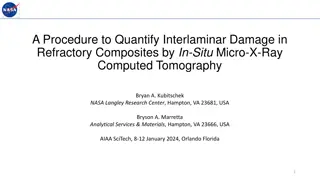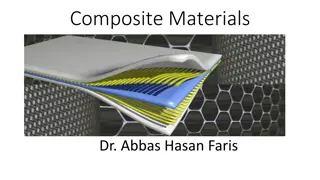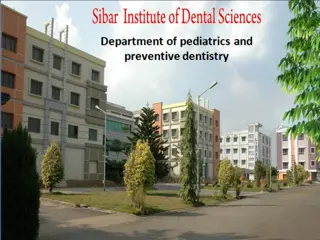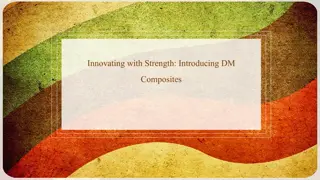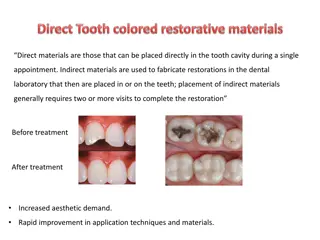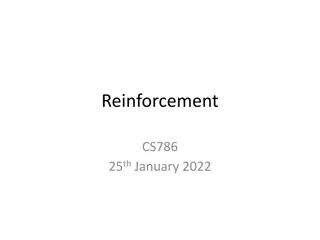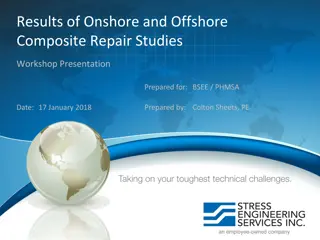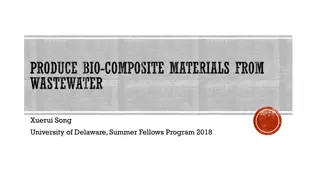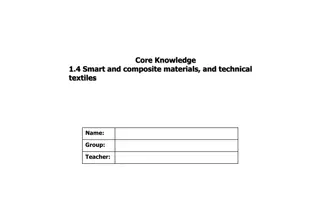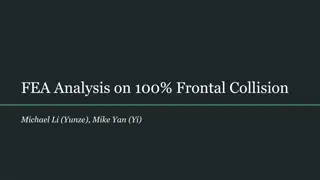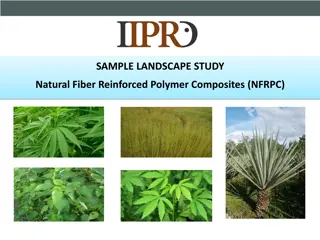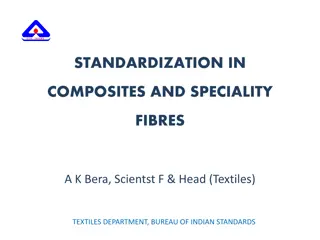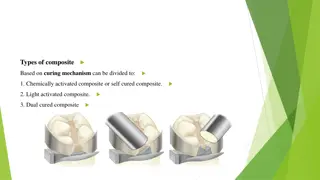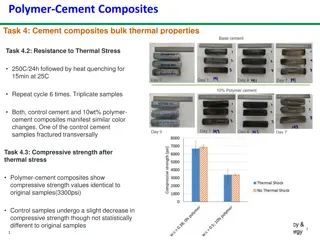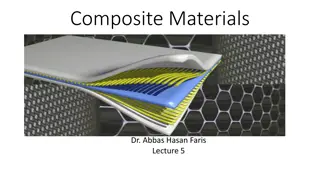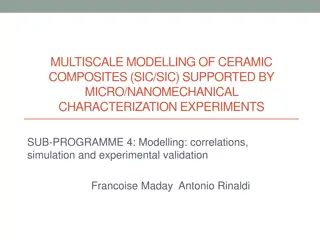Understanding Composite Materials: Reinforcement and Matrix in Composites
Composite materials consist of reinforcement and matrix components, each serving a specific purpose to enhance the properties of the composite. The reinforcement phase provides strength and stiffness, while the matrix transfers loads and protects the fibers. Different types of reinforcements and matrices contribute to the versatility of composite materials, leading to a wide range of applications across industries.
Download Presentation

Please find below an Image/Link to download the presentation.
The content on the website is provided AS IS for your information and personal use only. It may not be sold, licensed, or shared on other websites without obtaining consent from the author. Download presentation by click this link. If you encounter any issues during the download, it is possible that the publisher has removed the file from their server.
E N D
Presentation Transcript
Composite Materials Dr. Abbas Hasan Faris Lecture 3
Composite: Constituents There are two main constituents of composites: 1- Reinforcement 2- Matrix Reinforcing materials:- It is the materials that make reinforce the matrix. It has different forms may be fibers, particles, flakes, fillers, and woven made from glass, carbon, Kevlar or steel .etc The reinforcing phases are mainly divided according to the geometry of their individual particles into:
Reinforcement phase :The reinforcing phase provides strength and stiffness. In most cases, the reinforcement is harder, stronger, and stiffer than the matrix. The reinforcement is usually fiber or particulate.
The purpose of reinforcement is to enhance matrix properties. Reinforcements for composite materials can be in the form of fibers, particles, or flakes. Each has its own unique application, although fibers are the most common in composites and have the most influence on properties.
: DifferencebetweenMatrixandreinforcement REINFORCEMENT MATRIX This constituent is continuous and in greater quantity. This may be continuous or discontinuous. Based up on matrix composite is of 3 types. PMC,CMC,MMC. Based up on reinforcement type it can be fiber reinforced or particulate reinforced. Matrix transfers the load. Reinforcement bears the load. It protects individual fiber from surface damage due to abrasion and oxidation. The reinforcing phase provides strength, stiffness. In most cases these are stronger and harder than matrix. Example: aluminium, epoxy, polyester etc. Example: carbone, aramide, nylon, jute etc.
If the reinforcement is similar in all dimensions, it is a particulate reinforced composite If its shape is needle-shaped single crystals, it is whisker-reinforced composite If the reinforcement is cut into continuous filament, it is chopped fiber reinforced composite If the fiber is continuous, it is fiber composite. It can be broadly classified as: (1) Particle reinforced composites (2) Fiber reinforced composites Particulate composites have dimensions that are approximately equal in all directions. They may be spherical, or any other regular or irregular geometry. Particulate composites tend to be much weaker and less stiff than continuous fiber composites, but they are usually much less expensive. Particulate reinforced composites usually contain less reinforcement (up to 40 to 50 volume percent) due to processing difficulties and brittleness.
Points to further note are the following; - In particle reinforcement, the particles are generally equiaxial; that is approx. the same in all directions, but for fiber reinforcement there is a large difference in fiber length to fiber diameter, where l >> d. Fiber has a length that is much greater than its diameter. the length-to- diameter (l/d) ratio is known as the aspect ratio and can vary greatly. This has profound effects on the overall composite property, particularly the load bearing properties of the final composite. KIC= fracture toughness sy, = yield stress TS = Tensile strength E = Elastic modulus Dispersed phase: -- Purpose: MMC: increase sy, TS, creep resist. CMC: increase KIc PMC: increase E, sy, TS, creep resist. -- Types: particle, fiber, structural
Microstructures of metal and ceramics composites, which show particles of one phase spread in the other, are known as particle reinforced composites. Square, triangular and round shapes of reinforcement are known, but the dimensions of all their sides are observed to be more or less equal. Particles in composites are typically used not only to improve the mechanical properties, but often (also) to improve or modify properties such as heat resistance, electrical conductivity, damping of vibrations, hardness, resistance to high temperatures, etc. Dispersions usually consist of powders with particles of various shapes (spherical, pyramidal, lamellar, etc.).
and various sizes. There are usually used powders of inorganic compounds such as oxides (MgO, ZnO, BeO, Al2O3, ZrO2, etc.), carbides (SiC, TiC, B4C, Al4C3, etc.), nitrides (Si3N4, BN), borides, or silicates (kaolin, mica, glass beads, etc.). Glass is often used for weight reduction in the form of solid or hollow glass beads.
Reinforcements Other Graphite (C) Titanium Diboride (TiB2) Ceramics Silicon Carbide (SiC) Aluminum Oxide (Al2O3) Titanium Carbide (TiC) Boron Carbide (B4C) Metal Filaments Boron Steel Tungsten The Reinforcement (Secondary Phase) Function is to reinforce the primary phase Imbedded phase is most commonly one of the following shapes: Fibers Particles Flakes In addition, the second phase can take the form of an infiltrated phase in a skeletal or porous matrix Example: a powder metallurgy part infiltrated with polymer
Particulate composite:- Consist of one or more materials suspended in a matrix of another material. The particles can be either metallic or non-metallic. According to their size, we distinguish the particles as follows: 1- Large particles reinforced 2- Dispersion strength composite A classic example of polymers as a particulate composite material is carbon black in rubber (in the manufacturing of tires). A carbon black improves strength, stiffness, wear resistance. 1- Large particle reinforced composite: Have particles with a diameter of (1 m)or more and a volume concentration (25-50) % or more of the composite. One of their applications is cermet or (cemented carbides), a composite involving ceramic particles in a metal matrix that are widely used for the tips of cutting tools. Where particle-matrix interactions cannot be treated on an atomic or molecular level (microscopic). An example of a large-particle composite is concrete, which is composed of cement (the matrix), and sand and gravel (the particulates).
The first example of particle composites is the large particle composites. These are known as such because the interactions between the matrix phase and particle phase cannot be examined on a molecular, atomic level. Here the particle phase is generally tougher than the matrix and, in addition to acting as a cheap filler material, tends to resist localized deformations. Portland cement is an example of a large particle reinforced composite The composite s mechanical properties are increased with increasing particulate content; increasing this increases the interfacial area between the particulate and the matrix.
2- Dispersion strengthened composite: The strength of metal can be increased by small particles dispersed throughout the matrix. The diameter of particle (0.1 m)and volume concentration (1-15)% of the composite. For example the dispersion of aluminum copper compound throughout of alloy. To produce composite for general application, like a piston, connecting rod for automotive application. recognizable by a scanning electron microscope (SEM). Also, one way of introducing a dispersion of small particles throughout a metal uses sintering. Like dispersion of aluminum oxide (AL2O3) about (14%) throughout an aluminum matrix. Where the tensile strength is : 90 MPa for aluminum, WHILE 400 MPa for sintered aluminum
Dispersion strengthened composites have much smaller particle sizes whose interactions with the matrix can be seen at the molecular level. These particle-matrix interactions at the molecular level increase the overall strength of the composite. The small particles also resist dislocation motion throughout the composite in a similar manner to the pinning of precipitate-hardened metals. For dispersed strengthened composites, the matrix supports the load whilst small particles act to stop crack propagation through the matrix material. We can see examples of particulate composites with all three material types (metals, polymers, and ceramics).
3. Nanoparticles under 10-5 mm (below 10 nm), recognizable by a transmission electron microscope (TEM). For effective reinforcement, the particles should be small and evenly distributed throughout the matrix(. It is therefore necessary when producing the composite by adding dispersion particles to the melt to (often) use intensive mixing. The volume fraction of the two phases influence the behavior; mechanical properties are enhanced with increasing particulate content.
Classification: Particle-Reinforced (iii) Particle-reinforced Fiber-reinforced Structural Elastic modulus, Ec, of composites: -- two rule of mixture extremes: upper limit: E(GPa) + VpEp E = V E c m m 350 Data: Cu matrix w/tungsten particles lower limit: 1 Ec Em Adapted from Fig. 16.3, Callister & Rethwisch 8e. (Fig. 16.3 is from R.H. Krock, ASTM Proc, Vol. 300 +Vp Ep =Vm 250 200 63, 1963.) 150 vol% tungsten 0 20 40 60 80 100 (W) (Cu) Application to other properties: -- Electrical conductivity, se: Replace E s in equations with se s. -- Thermal conductivity, k: Replace E s in equations with k s. 17
The properties of the composite reinforced with large particle filler can be predicted using the 2 rules of mixture equations. Let s consider using for example the elastic modulus. The anticipated upper and lower values for E can be obtained from two fairly simple equations. The upper value is given by E subscript c (Ec,) the elastic modulus of the composite equals the product of the matrix volume and elastic modulus plus the product of the particle volume and elastic modulus. We can see from this equation that the greater the volume fraction of the particle the greater E subscript c. The lower limit of E subscript c is given by a similar, proportional equation here in blue. Interestingly this equation is expressed in reciprocal terms. Again the overall effect of a greater volume of particles is to produce a stiffer composite. When experimental data for a Cu matrix reinforced with tungsten particles is plotted as seen here we see excellent agreement with the theory as the values all fall between the two limits.



